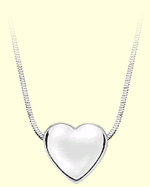 The
History of Platinum
The
History of Platinum
Although platinum may seem new, it is also legendary. The
ancient Egyptians and South American Incas prized it. France's
Louis XVI proclaimed it the only metal fit for royalty.
Legendary jewelers such as Cartier, Faberge and Tiffany
created their timeless designs in platinum. The world's
famous diamonds, including the Hope, Jonker I and Koh-I-Noor,
are secured by the permanence of platinum.
Platinum reached its peak of popularity in the early 1900's
when it was the preferred metal for all fine jewelry in
America. When World War II began, the U.S. government declared
platinum a strategic metal and its use in non-military applications,
including jewelry, was disallowed. To appease consumers
who preferred platinum's white luster, white gold was substituted
in platinum's absence.
Today, platinum again charms and enchants a new generation
of consumers.
What is Platinum?
Beneath its subtle beauty and understated elegance lie the
properties which make platinum truly unique.
Platinum is strong.It is the heaviest of the precious metals,
weighing almost twice as much as karat gold. Its strength
ideally secures diamonds and other precious gems. Even after
many years, platinum will not wear away or wear down.
Platinum is pure.In America, platinum jewelry contains
either 90% or 95% pure platinum. By comparison, 18K gold
is 75% pure and 14 karat is 57% pure gold. Only platinum
will never tarnish or lose its rich white luster. Because
platinum is so pure, it is hypoallergenic.
Platinum is rare.Ten tons of ore must be mined to produce
a single ounce of platinum. It takes five months to process
platinum ore into pure platinum. Only after this time can
skilled hands work their creativity and craftsmanship, transforming
platinum into pieces of wearable art.
How to Buy and Care for Platinum Jewelry
Platinum jewelry made in America contains either 90% or
95% pure platinum. Platinum jewelry marked "IRIDPLAT"
contains 90% platinum and 10% iridium. When marked "PLAT"
an item is at least 95% platinum, with 5% ruthenium.
Whether you are choosing a ring, pin, bracelet, necklace
or bridal jewelry, you will find new and sophisticated platinum
designs.
Platinum jewelry should be cleaned the same way you clean
other fine jewelry. Use a pre-packaged jewelry cleaner or
have it professionally cleaned by your jeweler. As with
all precious jewelry, store with care, not allowing pieces
to touch or scratch each other.
An experienced jeweler can assist you in selecting platinum
jewelry that will bring pleasure to you and the recipient
for years to come.
Information is provided courtesy of the Platinum Guild
International, USA.

